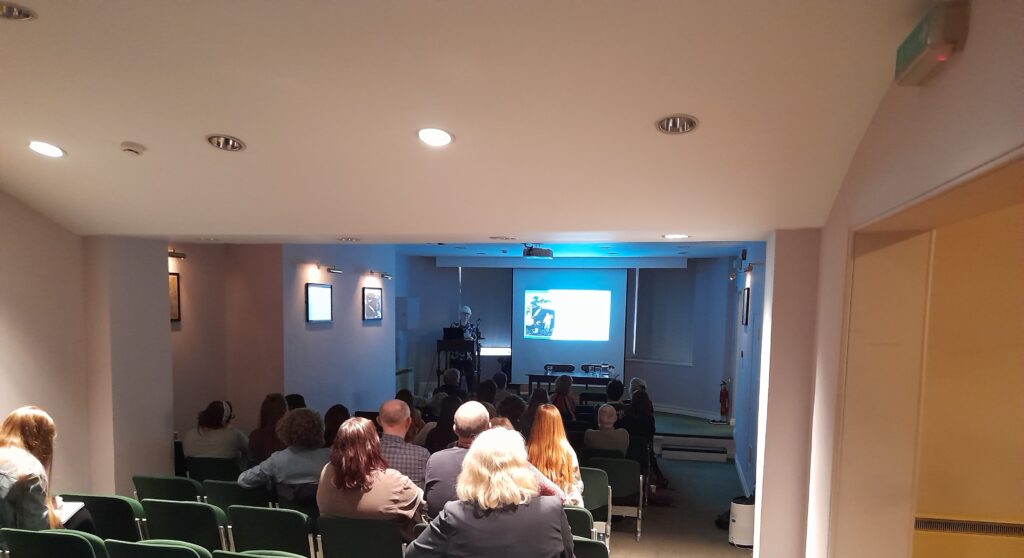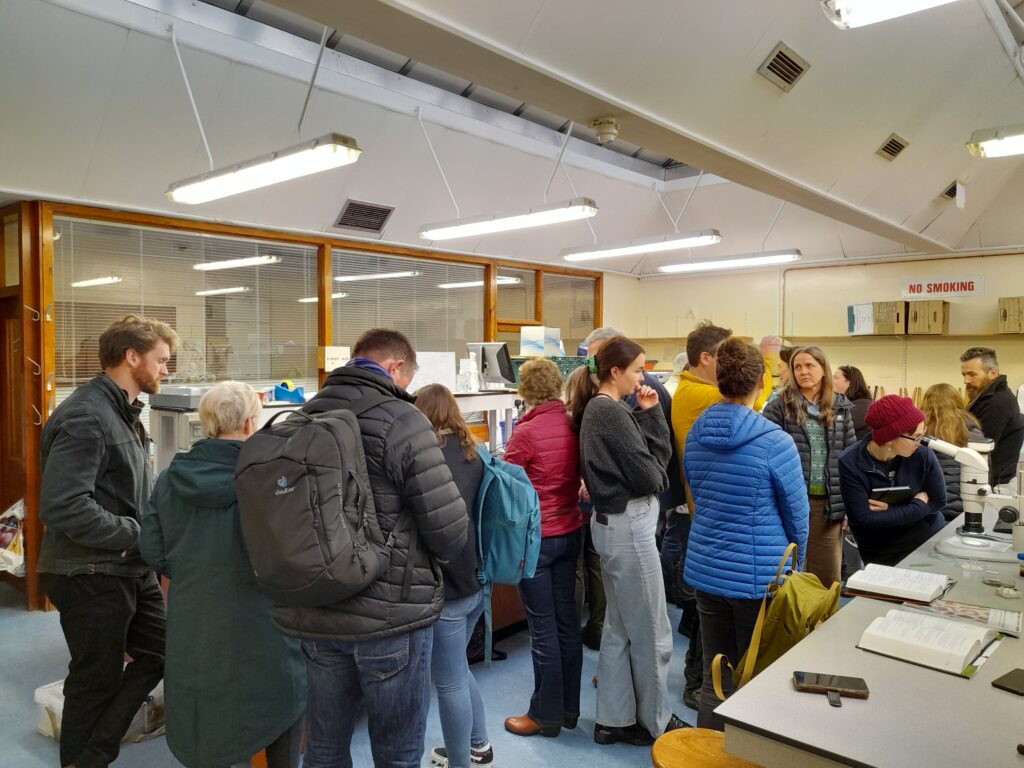Our 2023 conference took place on 6th May at the Royal Society of Antiquaries. The day was dedicated to the memory of Dr Eileen Reilly and it was lovely to see her family and friends on the day. Thanks to all who took part and attended!


Our 2023 conference took place on 6th May at the Royal Society of Antiquaries. The day was dedicated to the memory of Dr Eileen Reilly and it was lovely to see her family and friends on the day. Thanks to all who took part and attended!

Thanks to everyone who participated in the EAI/IAI CPD course last week.

Resources from the day are available here.
Some of the resources for tomorrow’s EAI/IAI CPD course are now available here: https://eaireland.net/blog/cpd-resources/
EAI’s CPD course for members of the IAI, ‘Sampling for the study of environmental remains from archaeological excavations’, will be running on Wednesday, 15th March 2023.
The course will be taking place in the Ardmore Annexe seminar room and laboratories, in UCD School of Archaeology.
Here’s the schedule for the day:
09.30 – 10.00 Coffee/Tea (Ardmore Annexe Common Room)
Session 1
10.00 – 10.08 Introduction (Dr Steve Davis)
10.08 – 10.38 Wood and charcoal remains (Dr Ellen OCarroll)
10.38 – 10.53 Charred non-wood plant macro-remains (Dr David Stone)
10.53 – 11.08 Phytoliths and dental calculus (Dr Robert Power)
11.08 – 12.15 Laboratory session on charred remains and phytoliths (10 minutes per group at each microscope followed by Q and A):
12 .15 – 12.30 Coffee/Tea (Ardmore Annexe Common Room)
Session 2
12.30 – 12.45 Pollen (Dr Karen Molloy and Dr Daisy Spencer)
12.45 – 13.00 Waterlogged non-wood plant macro-remains (Nikolah Gilligan)
13.15 – 13.30 Waterlogged insects (Dr Steve Davis)
13.30 – 13.45 Micromorphology (Dr Helen Lewis)
13.45 – 14.45 LUNCH (UCD cafes/bring your own)
Session 3
14.45 – 15.35 Laboratory session on waterlogged remains and micromorphology (10 minutes per group at each microscope):
Session 4
15.35 – 16.10 Interactive session: how to develop a sampling strategy (Dr Ellen OCarroll and Dr Penny Johnston)
16.10 – 16.25 Concluding discussion
Our training course in Environmental Archaeology, run by EAI with the Institute of Archaeologists of Ireland, is coming up soon (Wednesday 15th March).
The aim of the one-day course is to highlight the importance of recovering and studying
environmental remains from Irish archaeological sites. These studies can make a huge contribution to our understanding of the interaction with and the impact on the environment of past peoples.
The course will introduce participants to a range of environmental remains:
i) Micro plant remains as proxies, principally pollen.
(ii) Plant macro remains of wood and charcoal.
(iii) Plant macro remains of fruits, seeds, and grains.
(iv) Micro faunal remains principally the insects.
(v) Soil micromorphology: a principal technique of the geoarchaeologist.
(vi) Phytoliths and dental calculus.
Sampling strategies will also be discussed.
See the IAI website for more details.
How do we store the organic remains that are analysed by environmental archaeologists? It’s really important that these are available for follow-up work by the researchers of the future. This is a frequent topic at EAI meetings. One of our members, Penny Johnston, has been involved in writing a collaborative paper to discuss why we think this is important. The article is open access and is available for all to read by clicking this link.

We’d like to congratulate one of our members, Dr David Stone who won the Máire de Paor Award for his PhD thesis. (David is pictured here with his PhD supervisor, Dr Meriel McClatchie, who is also an EAI member!) Some of David’s award-winning research has recently been published in Vegetation History and Archaeobotany. It’s an open access article so it is available for everyone to read, here’s the link.
EAI organised a training day for TII archaeologists on 19th October 2022. Practicals included hands on experience processing samples and examining plant macro-remains, insect remains and pollen.

Our next seminar in the series (and our first in 2022) will take place online on Thursday 27th January 2022 from 7pm to 8.30pm (Dublin time).
We will feature short presentations and discussion on the development of the new zooarchaeology sampling guidelines from TII (download here). The presentations will be by Dr Fiona Beglane (Lecturer, IT Sligo; chief editor of the new guidelines) and James Eogan (Senior Archaeologist, TII). The discussion will be chaired by Mick Monk (retired, formerly Department of Archaeology, University College Cork).
Register here: https://www.eventbrite.ie/e/environmental-archaeology-in-ireland-seminar-tickets-251836599047
Speaker 1: James Eogan, Transport Infrastructure Ireland.
Title: TII and Environmental Archaeology: Collaboration, Quality and Dissemination
Bio: James Eogan is a Transport Infrastructure Ireland (TII) Senior Archaeologist. As Project Archaeologist he has managed archaeological services contracts on many TII-funded road schemes over the past two decades. He coordinated the preparation of the TII Paleoenvironmental and Zooarchaeological sampling guidelines. In this presentation, he will set out the reasons why TII values the contribution of environmental archaeology and some of the lessons that have been learned.
Speaker 2: Dr Fiona Beglane, IT Sligo
Title: An Introduction to the Zooarchaeological Sampling Guidelines: Best Practice for the Treatment, Analysis and Curation of Animal Bones from Archaeological Excavations
Bio: Dr Fiona Beglane is a lecturer at the Institute of Technology, Sligo, and a consultant zooarchaeologist. Her research focuses mainly on medieval archaeology, the archaeology of hunting, the use of scientific techniques in archaeology and in community archaeology.
The second installment of our Environmental Archaeology seminar series takes place on Thursday 21st October (19:00 – 20:30 IST) and features presentations from Dr Penny Johnston of The Department of History, Politics and Philosophy at Manchester Metropolitan University, and Dr Scott Timpany of The Archaeology Institute, University of the Highlands & Islands, who will both be discussing aspects of their current research projects in Ireland and Scotland.
Dr Penny Johnston: Plant remains and chronology: preliminary results from two late 4th millennium sites in Louth.

Analysis of charred macro-plant remains, both seeds and charcoal, result in identified and quantified material that can be used to obtain radiocarbon measurements, which in turn help to establish chronologies for sites and site types. Previous research projects have successfully used short-lived material, such as charred grain, to create tightly refined Bayesian chronologies (for example, for Irish rectangular structures, c. 3700 BC).
This talk will introduce Project Time, an ongoing research project that focuses on the period from 3500 to 1500 BC. The aim is to gather pre-existing radiocarbon data from late fourth and third millennium sites and, hand-in-hand with this, to obtain new radiocarbon measurements after analysing plant and animal remains from sites with relevant material culture (such as Grooved Ware pottery).
I will present some preliminary plant remains results from two relevant sites in Louth, at Balregan and Balgatheran, and will discuss these within the context of the current discourse on the exploitation of cultivated and wild plant resources in the period after 3500 BC.
Dr Scott Timpany : Fire in the Hole: an anthracological investigation of wood-fuel resources used in metalworking furnaces at Culduthel, Invernesshire.
The Iron Age site at Culduthel was home to a community of skilled artisan metalworkers who produced high-quality personal objects some of which were likely to have been traded with Roman communities, from the presence of Roman coins and glass, together with their contemporary Iron Age neighbours. Radiocarbon dates from Culduthel show a community was present here from around 810-550 cal BC to cal AD 130-340 and lived in impressive roundhouses with monumental architecture demonstrating their wealth, whilst working in specialised workshops that were found to still contain furnaces with fills of iron slag and charcoal. This project has sought to take a slightly different look at the exploits of this metalworking community through analysing the wood charcoal remains from three furnaces in one of the workshops, Structure 15. Through the anthracological analysis of this material questions can be asked on what trees were resourced for wood fuel for the metalworking activity? Can any woodland management strategies (e.g. coppicing) be identified that would suggest the inhabitants were sustainably utilising their woodland resource? Can any evidence for the storage of wood fuel be seen and/or the use of unseasoned wood in the fuel assemblages? This project is the first such analysis of the furnace wood-fuel at Culduthel and one of a small number of anthracological analyses examining woodland management themes in relation to Iron Age metalworking worldwide.
The presentations will be followed by a chaired panel discussion.